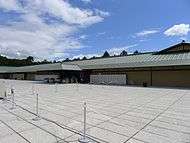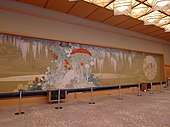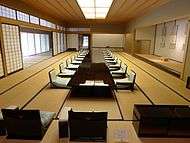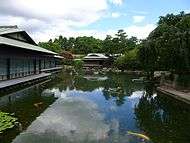Akasaka Palace
| Akasaka Palace (State Guest House) | |
|---|---|
|
Native name Japanese: 赤坂離宮(迎賓館) | |
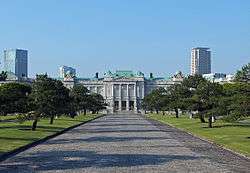 Akasaka Palace | |
| Location | Moto Akasaka, Minato, Tokyo, Japan |
| Coordinates | 35°40′48″N 139°43′43″E / 35.68000°N 139.72861°ECoordinates: 35°40′48″N 139°43′43″E / 35.68000°N 139.72861°E |
| Area |
15,000 m2 (160,000 sq ft) (floor space) 117,000 m2 (1,260,000 sq ft) (site) |
| Built | 1899-1909 |
| Built for |
Crown Prince Daijō Tennō |
| Designated | 2009 |
 Location of Akasaka Palace (State Guest House) in Japan | |
Akasaka Palace (赤坂離宮 Akasaka rikyu), or the State Guest House (迎賓館 Geihinkan), is one of the two State Guesthouses of the Government of Japan. The palace was originally built as the Imperial Palace for the Crown Prince (東宮御所 Togu gosho) in 1909. Today the palace is designated by the government of Japan as an official accommodation for visiting state dignitaries. Located in the Moto-Akasaka, Minato, Tokyo, the building took on its present function in 1974, having previously been an imperial detached palace. In 2009 the palace was designated as a National Treasure of Japan.[1]
Overview
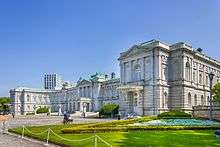

- Location: Tokyo, Minato-ku, Moto-Akasaka-chome No. 1
- Site area: 117,000 m²
- Total floor space: approximately 15,000 m²
The building has 15,000 m² of floor space, and together with a smaller structure in the Japanese style, occupies a 117,000 m² site.
The main building is a Neo-Baroque style Western building in Japan,[2] resembling in particular Hofburg Palace, and it is one of biggest buildings constructed during the Meiji period.[1]
Outside and around the palace area is a footpath unobstructed by road crossings. The footpath is about 3.25 km long (roughly 2 miles).
The nearest station to the Palace is Yotsuya Station.
History
The territory that Akasaka Palace now occupies was part of the residence of Kishū Domain, one of the major branches of the ruling Tokugawa clan, during the Tokugawa period.[2] After the Meiji Restoration, the Owari presented the land to the Imperial Household.
Designed by the architect Katayama Tōkuma (片山 東熊) (a student of Josiah Conder), the Neo-Baroque structure was constructed between 1899 and 1909 as a residence for the Crown Prince. Originally it was named Tōgū Palace (ja. lit. "Palace for the Crown Prince") but was later renamed Akasaka Palace when the Crown Prince's residence was moved.[2]
Regent Crown Prince Hirohito resided at Akasaka Palace from September 1923[3] until September 1928, two months before his coronation. The move was intended to be temporary, but lasted five years. During the renovation of his contemporary residence, Hirohito intended to lodge temporarily at Akasaka Palace, moving in on August 28, 1923. Four days later, Japan was hit by the Great Kantō earthquake[3] on September 1. During his residence in Akasaka Palace, Prince Hirohito married and fathered two daughters, Princess Sachiko (who died at 6 months old) and Princess Shigeko.
After World War II the government of Japan relieved the Imperial household of Akasaka Palace. Several governmental offices were installed in the palace, including the National Diet Library which was founded in 1948,[4] Cabinet Legislation Bureau and Organizing Committee of Tokyo Olympics 1964.
Through the economic revival of the country after World War II, the Japanese Government found the necessity of establishing a state guest house. The former residence of Prince Asaka, currently Tokyo Metropolitan Teien Art Museum, had been used as the state guest house, though it was too small for the purpose. It was decided in 1967 to renovate the former Akasaka Palace as the new state guest house. The renovation was led by the architect Togo Murano with more than five years and 10.8 billion yen, which completed in 1974.
The first official state guest who stayed in the renovated palace was Gerald Ford in 1974, which was the first visit of the incumbent President of the United States to Japan. Since then, the palace has provided accommodations for state and official guests and a venue for international conferences, which have included the G7 summit meetings (1979, 1986 and 1993) and APEC[2] summits.
The venue had been closed from 2006 to 2009 for renovation, and it was reopened in April 2009. In December 2009, the main building, the main gate and the garden with fountain were designated as a National Treasure of Japan.[1] It was the first designation of assets after Meiji Restoration as a National Treasure of Japan.
 Akasaka Palace main entrance
Akasaka Palace main entrance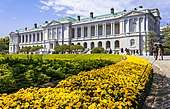 Main Garden
Main Garden The Annex of the State Guest House, Yushintei
The Annex of the State Guest House, Yushintei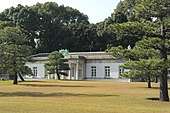 Safety facilities and national treasure accompanying Akasaka-yuen
Safety facilities and national treasure accompanying Akasaka-yuen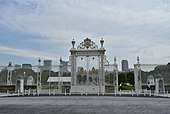 Gate of Akasaka Palace
Gate of Akasaka Palace- The National Diet Library existed in the present-day State Guest-House (former Akasaka Detached Palace), 8 June 1948
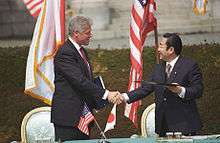 Summit between Prime Minister Hashimoto and President Clinton in 1996 at Akasaka Palace
Summit between Prime Minister Hashimoto and President Clinton in 1996 at Akasaka Palace
Kyoto State Guest House
- Location: Kyoto , Kyoto City, Kamigyo-ku, Kyoto-Gyoen National Garden
- Lot size: approximately 20,140 m²
- Structure: Reinforced concrete construction , 1st floor above ground (basement 1st floor)
- Total floor space: approximately 16,000 m²
History
During the Edo period (1603 – 1868) a Garden House and multiple mansions of aristocrats stood in the northeastern part such as of the Yanagihara family and Kushige family. The Kyoto Imperial Palace is in the northern part of Kyōto-Gyoen National Garden (京都御苑). It was constructed in 1331 and the Emperors lived there until 1869. There are also Sentō Imperial Palace gardens.
In 1994, to commemorate the twelve-hundredth (1200th) anniversary of the establishment of the ancient capital of Heian-kyō (平安京), there was growing momentum toward building a Japanese-style guest house in Kyoto. In October 1994, approval was obtained from the Cabinet of Japan for "the construction of a guest house facility." The government decided to build a state guest house within the Kyoto Gyoen National Garden. In March 2002, construction of the Kyoto State Guest House (main structure) started. Construction completed in February 2005 and the Kyoto State Guest House was opened on 17th April 2005. The total floor space of the new facility is 16,000 m² and the lot is 20,140 m². Since July 2016 the Kyoto State Guest House's all-year public opening started.[5] It was designed by Nikken Sekkei. The Western-style of the Akasaka State Guest House contrasts with the Japanese-style buildings of the Kyoto State Guest House.
The first state guest after the opening of the Kyoto State Guest House was Nguyễn Minh Triết, former President of Vietnam (stayed 28 - 29 November 2007).
See also
- Imperial Hotel, Tokyo
- Blair House, the state guest house of the United States
- Hyderabad House, the state guest house of India
- Diaoyutai State Guesthouse, the state guest house of the People's Republic of China
- Grand Hotel (Taipei), the state guest house of the Republic of China
References
- 1 2 3 国宝・重要文化財(建造物)の指定について (PDF) (in Japanese). Tokyo: Agency for Cultural Affairs. October 16, 2009. Archived from the original (PDF) on October 8, 2010.
- 1 2 3 4 Cabinet Office, Government of Japan (2008). 迎賓館 [Reception hall] (in Japanese). Archived from the original on March 10, 2010. Retrieved March 4, 2010.
- 1 2 昭和聖徳記念財団 (Showa Memorial Foundation). 6月公開「山本内閣親任式の図」 (in Japanese). Retrieved March 4, 2010.
- ↑ 国立国会図書館 (National Diet Library). 沿革 [History] (in Japanese). Archived from the original on September 26, 2010. Retrieved March 4, 2010.
- ↑ "History - Kyoto State Guest House". Cabinet Office, Government of Japan. Retrieved 2018-09-24.
External links
![]()
